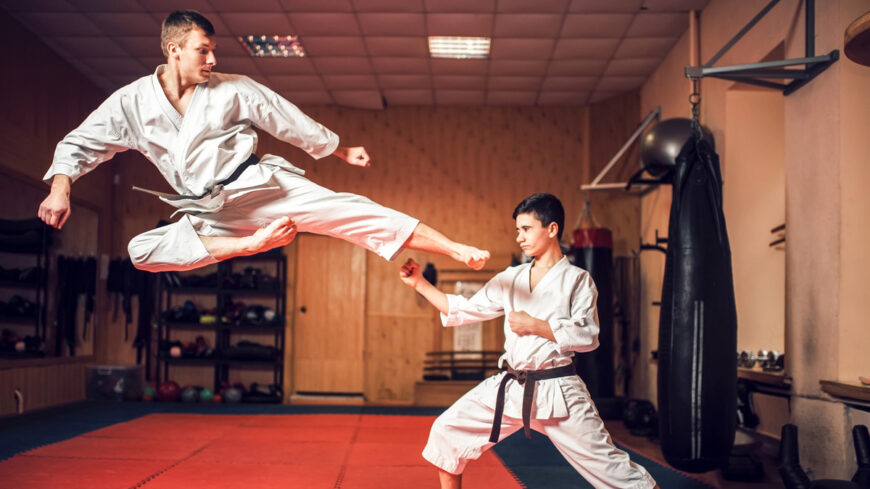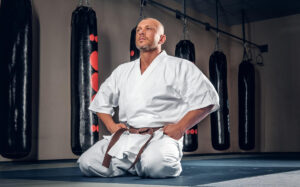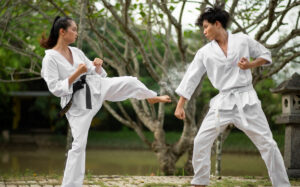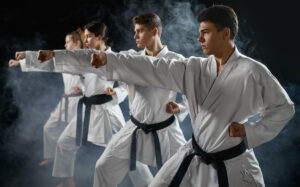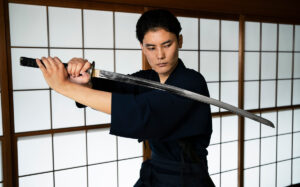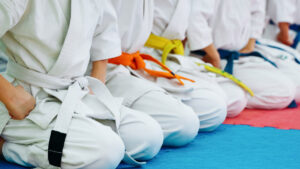Kenpo is one of the various styles of martial arts that originated in Asia during the region’s long and illustrious history. Both Chinese and Japanese styles of martial arts contributed to its development.
In contemporary times, however, it is more commonly associated with the martial art of Karate. The many different styles emerged later on. So, what exactly is the art of Kenpo Karate?
History of Kenpo Karate
During the years following the attack on Pearl Harbor, William Kwai Sun Chow studied directly under Mitose as well as Thomas Young, who, as far as we are aware, was the first individual in America to be promoted to the rank of black belt by Mitose. Additionally, he was an instructor’s assistant for each of them, and Chow would eventually earn the rank of black belt and become Young’s assistant instructor.
By 1949, Chow had moved on from Mitose’s club and started his establishment. After opening a dojo, he started teaching Karate in Hawaii’s parks and at the YMCA. A few of Mitose’s pupils also started training with Chow.
Kenpo Karate was the new name he gave to the teaching style. That move officially separated him from Mitose’s Kenpo Jiu-Jitsu, and as a result, he is now recognized as the official founder of Kenpo Karate or American Kenpo Karate; you might not want to say that around Ed Parker.
Young referred to his form as a “War Art” and not a “Martial Art.” A martial art emphasizing street fighting and individual self-defense is designed specifically for students and practitioners to learn.
The increasing number of people who came to learn Kenpo Karate from Chow coincided with the expansion of his fame, which led to him being referred to as a Great GrandMaster later on.
His students include such names as Ralph Castro, who founded Shaolin Kenpo and eventually became a Great Grand Master, Adriano Emperado, Chow’s top student and founder of Kajukenbo, Masaichi Oshiro (Te-Ken Jutsu Kai), and others that would carry both Mitose and Chow’s arts of Kenpo Jiu-Jitsu and Kenpo Karate to the mainland of the United States, where both styles would evolve significantly.
Now, for the one you’ve all been waiting for, Ed Parker. So, let’s start. 1931 is the year that Parker was born in Hawaii. While growing up there, he is said to have studied Judo and Kenpo Karate under William K. S. Chow and his brother Frank Chow while serving in the Coast Guard and attending Brigham Young University.
After that, in 1954, he founded his first dojo in Provo, Utah, and two years later, in 1956, he launched a second club in Pasadena, California. He believed Kenpo Karate was not sufficiently contemporary for the times, so he developed the techniques to make them even more “street” intensive than Chow had taught.
Ed Parker’s American Kenpo would become the name of Parker’s officially sanctioned style. It featured more circular motion, many methods combined in various ways depending on the circumstances, faster kicks and punches with more powerful and crippling effects, and just more destructive than Mitose’s style.
This new style made it more adaptable to the acquisition and assimilation of components of other styles, such as Muay Thai kickboxing and Escrima, in addition to Jiu-Jitsu, which made it more open to innovation.
You wouldn’t just see standard kicks, punches, or the multiple variations of a block if you went to a Parker school or a descendant of Parker’s forms. Instead, ground combat, kickboxing, and possibly even fighting with knives and sticks are likely to be seen.
Early students and practitioners of Parker’s system included Al and Jim Tracy. Al and Jim Tracy would go on to refine Parker’s system to standardize the techniques’ order for each belt and associated katas. Al and Jim Tracy are considered the founders of the Tracy Karate System. In later years, the two of them would create their karate school, which they properly named Tracy’s Kenpo Karate.
Several famous people, including Elvis Presley, Robert Conrad, and Warren Beatty, were among those who Parker trained during his career. Later, he would appear in several films and television shows, including The Revenge of the Pink Panther.
Regardless of the urban legends, Ed Parker lived a remarkable life due to a great deal of credit for the widespread adoption of Kenpo in the United States and the expansion of the art’s scope so that it could incorporate elements of a variety of different styles.
Where Did Kenpo Karate Originate?
The original name for Kenpo was Quanfa, which means “Fist Method” or “Fist Law.” Kenpo was developed in China. It is claimed that it then made its way to Japan some 700 years ago, where martial artists enthusiastically adopted it. This origin is where the term “Kenpo” originated, which is why some people refer to it as “Chinese Kenpo.”
It is possible to translate Kenpo as “Fist” (Ken) and “Method” or “Law” (PO). Others argue that PO should only ever translate as “law.” However, because the original Chinese is translated to either of these, the word “Kenpo” can be rendered in both ways. Even though the word “law” has a stronger resemblance to the word “killing.”
The Komatsu and Yoshida clans, who saw their styles of Kenpo as being more authentic than those of other schools, produced some of the art’s most prominent practitioners. Karate emerged as the preeminent kind of unarmed combat martial arts in its many forms as Japan’s many warring clans developed them over several centuries. Despite this, the Fist Law became the governing principle for the Komatsu and Yoshida clans.
As the Japanese style of Kenpo evolved and took root in the Komatsu and Yoshida clans, the Chinese style went through extensive changes. As a result, the Chinese style is nothing like what it was when it was originally developed. Japan’s Komatsu and Yoshida clans are credited with perfecting Kenpo and bringing it to the United States after the turn of the 19th century.
However, a significant portion of modern American Kenpo bears little resemblance to this style due to how the art has changed and evolved over the years. The concepts of morphing and developing into new forms will be recurrent here.
Kenpo Karate in America
The martial art of Kenpo was introduced to the United States for the first time in the early 1900s on the island of Hawaii. Kiyoko Komatsu, a young girl from Japan, considered a Master or Grand Master in Kenpo today, is credited with being the one who first introduced the technique.
Kiyoko married Otokichi Mitose in 1912 when she was 22 years old. It provides a slightly more stable foundation to build upon. After some time, in 1917, they welcomed a boy into the world who they named James Mitose. They took him to Japan at age three to live with his maternal grandfather, Sakuhi Yoshida.
So, when James was three years old, the family moved to Japan. During that time, his grandfather instructed him in the art of Kenpo. James is the first person of Mitose descent to achieve mastery in the Yoshida style of Kenpo.
However, he did come back, this time as a Yoshida Kenpo style expert. After the attack on the USS Pearl Harbor, James became the first Kenpo master in Hawaii to start publicly instructing the general public in what he dubbed Kenpo Jiu-Jitsu. He continued doing this for another decade; his club was the seed from which all Kenpo in the West sprang.
As a side note, the martial art of Shorinji Kempo was also established in Japan after World War II. The Shorinji style is sometimes compared to the Shaolin school of Kung Fu because it emphasizes the religious part of its practice to match its style.
It is important to remember that the name “Kung Fu” serves in some ways as an umbrella term for “Chinese martial arts” in general. Karate is representative of practically every martial art practiced in Japan. And Kenpo refers to any of its several styles that are practiced in the West. They come down to the distinct philosophies of the masters that practiced various styles.
What Is American Kenpo Karate?
Ed Parker is, as was noted earlier, the most well-known name in American Kenpo. In Hawaii, where he lived for six years, he was also a pupil of William Chow; nevertheless, he developed his technique differently. He brought it to the level of popularity that it maintains to this day.
Due to the numerous issues that surround his rank and the efficacy of the teachings in the first place, many Kenpo masters do not regard his teachings to be genuine Kenpo and so do not follow them. His instructor, Chow, claimed that Parker never even achieved the level of black belt, but Parker asserted that this was not the case.
When developing his form of American Kenpo, he borrowed strategies from various martial arts and schools, but Kung Fu was the primary influence. It uses English names for techniques (Thundering Hammers, Prance of the Tiger, etc.) to make them sound more appealing to people riding the bandwagon of popularity that Asian martial arts had at the time in the United States of America. It contains a lot of very flashy moves and combinations.
He did, however, help put the sport on the map by deftly transforming Chow’s principles into a straightforward system to master. Because of the dazzling maneuvers and performances, it continues to be one of the most popular forms of Kenpo, particularly in the entertainment business.
5 Styles of Kenpo Practiced in the United States
The fact that there are several different Kenpo styles in use today, just like there are several different martial art forms, is likely to generate confusion among individuals interested in learning Kenpo for the first time.
We will now discuss the primary Kenpo styles to clear any confusion. Note that the spelling “Kempo” is also used instead of “Kenpo.”
Shaolin Kempo Karate
Fred Villari, who was a student of a different technique called Kajukenbo, was the one who devised this approach. The Shaolin Kempo Karate style utilizes the five animal Chaun Fa methods and is considered more similar to Kung Fu than other Kenpo styles.
In addition to Aikijujitsu and White Tiger China Na skills, this method also teaches them. It is a well-known method that is routinely taught all over the continent of North America.
Kosho Ryu Kenpo
In the 15th century, monks were responsible for passing on this method to the Mitose family. Kosho is an amalgamation of several different fighting styles and philosophies, including Shaolin Chaun Fa, Jujutsu, Kyudo, and the Rinzai school of Zen. Because Kosho, which translates to “old pine tree,” was the name given to it by the Mitose clan, this Kenpo style is sometimes referred to as the “old pine tree style.”
American Kenpo Karate
This particular Kenpo style, which has its roots in Chinese Kenpo Karate, is among the most well-known of all the Kenpo variants. It was made popular by Ed Parker, who used the strategies he had learned from William Chow, as indicated earlier in this article.
He cleverly took these ideas and reorganized them into a system that was straightforward to comprehend. It was renamed American Kenpo Karate after Parker, who is credited with having contributed the majority of the system’s innovations. The style has been depicted in films such as “The Perfect Weapon,” showcasing martial art.
Kajukenbo
Siju In the late 1940s, the Hawaiian Palama settlements were the birthplace of a new martial art known as kajukenbo. Adriano D. Emperado is generally regarded as the man responsible for the art’s establishment. It was developed by five martial arts practitioners who wanted to create a fighting system that was effective at all speeds and ranges.
They created the style to complement the best aspects of all five styles to create a fighting system that was effective across the board. Emperado was a skilled practitioner of Escrima and Kempo, but Fred Villari developed his unique approach to the martial art of Kempo.
Shorinji Kempo
Doshin So established this school of Kempo in 1947 and decided to combine aspects of Zen Buddhism, which is practiced in Japan, into his techniques. Even though there is a strong divide between the technical aspects of Shorinji Kempo and the religious aspects of the art, it is generally accepted that Shorinji Kempo is both a fighting and a religious style of Kempo.
Dojos are the only term that can be used to refer to branches of the style located outside of Japan. In Japan, the style branches are referred to as “doing” temples.
Kenpo Karate Techniques
Kenpo techniques are entirely dependent on rapid, coordinated body movements. A student overwhelms an opponent by moving quickly with his body. Modern Kenpo is based on kicks and hand strikes. In addition, it stresses blocking, throwing, blocking, striking, and pressure point manipulations.
The Ideal stage, the What-If stage, and the Formulation stage are the three levels or stages in which Kenpo is taught. One must begin with the fundamental white belt and work their way up to the black belt, which designates a person as a master in Kenpo Karate after steadily overcoming varying degrees of difficulty. Various organizations use different belt systems.
Until one becomes reflexive and natural, one must learn the fundamental techniques. Because rapid movements are necessary for effectiveness, so much practice, enthusiasm, and consistency are required.
Kenpo and Karate – What’s the difference?
As has been established, Kenpo and Karate don’t differ much.
Naturally, this depends on your teacher’s teaching methods and priorities. For instance, some dojos will interpret the term “Kenpo” literally and emphasize fist strikes while keeping foot strikes to a minimum.
Another difference between Kenpo and Karate is that Kenpo has a different grade system. For instance, the times required to earn different promotions and belt colors will vary.
Again, this may vary depending on each teacher’s grading standards and the schools they teach. In addition, gis used in Kenpo may be of a different color and length from those used in Karate.
In other words, the primary distinction undoubtedly stems from the basic spiritual principles of Kenpo. Modern civilization has lost sight of the fundamental principles upon which most traditional combat arts were founded.
Although it has already been established, martial arts were more about upholding a moral code than engaging in physical combat. It may be challenging to comprehend this idea, yet things were very different hundreds of years ago.
Karate is still primarily concerned with upholding moral principles, but in most contemporary dojos, this is probably less common and less applicable than in sports Karate, where the goal is to win.
Because of this, it might be said that, aside from minor details, the fundamental distinction between Karate and Kenpo is that the former still emphasizes philosophy while the latter emphasizes physical rather than mental development.
To further complicate matters, keep in mind that Okinawan Kenpo is more traditional in line with its mindset, whereas American Kenpo is more likely to be akin to contemporary Karate in terms of its principles.
Some American Kenpo practitioners frequently refer to it as “American Kenpo Karate,” which is also not incorrect. It is an honorable nod toward the origins of the discipline since the fundamental principles of Kenpo are based on Shaolin Kung fu and Karate. That said, Kenpo and Karate are very similar or slightly different depending on who you ask.
Kenpo Karate Belt Order
Like many other forms of martial arts, Kenpo uses a belt ranking system to denote a practitioner’s experience level, rank, and overall proficiency. The aim is to progress from novice to expert by beginning with white and ending with black.
In most cases, the colors can be summed up as (in descending order, beginning with beginner and ending with master):
- White
- Yellow
- Orange”
- Purple
- Blue
- Green
- Brown (with various degrees once achieved)
- Black (with various degrees once achieved)
In addition, several schools offer distinct variants for children and adolescents to participate in. Some people mark their progression within the belt they are currently wearing with stripes or hash marks sewn into the belt. Others cut the belts into sections.
In some schools, the order of the purple belt, the blue belt, and the green belt is switched around in some regions. In most cases, the brown belt is in the same position. In addition, certain schools use red belts, typically ranked slightly below or even above black belts.
Read also: Karate Belt Order and Taekwondo Belt Levels.
FAQs
How should I dress for karate Kenpo classes?
When attending your first Kenpo karate class as a novice, you should dress in activewear that makes you feel comfortable moving about. Eventually, once you’re ready to commit to Kenpo karate, you can buy a gi package.
Do you have to be athletic or particularly strong to do Kenpo karate?
Not at all! Kenpo Karate is made to accommodate people with all kinds of body shapes and physical prowess. Technique matters in Kenpo, not physical prowess, stature, or strength.
Am I too old to begin learning Karate Kenpo?
Due to the misconception that they are too old to pursue their interest, many adults interested in martial arts like Kenpo karate talk themselves out of doing so. The truth is millions of people are taking Kenpo karate programs, proving that you are never too old to learn the arts.
What if I'm not in good shape?
Not being in shape is one of the reasons why adults believe they cannot practice Kenpo karate. While it’s undeniably true that being in high physical form will make studying martial arts easier, you don’t have to be in tip-top shape to benefit from a Kenpo karate session.
How old must a child be to begin Kenpo karate?
Different children mature at various rates. Children between the ages of 4-6 can begin their beginner’s class in Karate Kenpo. Due to the emphasis on gross motor development, coordination, and technique identification during the beginner’s sessions, these lessons are developmentally appropriate.
Read also: 25 Deadliest Martial Arts In The World
Conclusion
We covered nothing but the basics of Kenpo Karate. There is a lot more to this noble martial art. As we have discussed extensively, Kenpo karate is a Chinese martial art modified by the Japanese and eventually modified to fit the American Culture. There are 5 styles, all of which are learned through the typical colored belt system common to martial arts.

